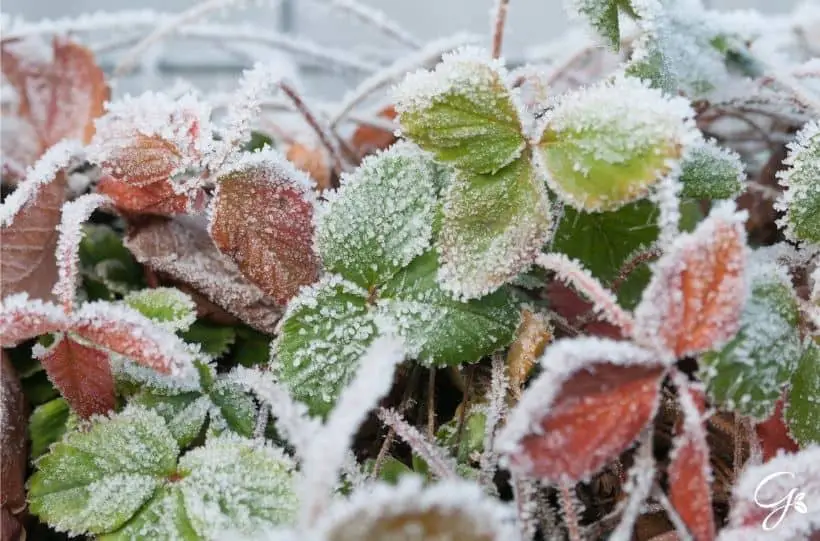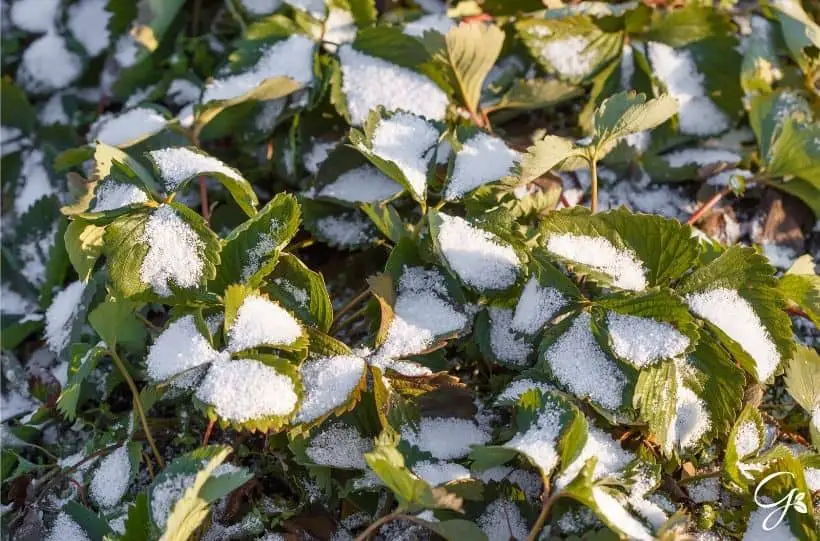How To Overwinter Strawberry Plants
Strawberries are a firm favorite crop gardeners love to grow. They are easy to maintain, regrow each year, and taste delicious!
You may also have grown strawberries during the warmer months of the year. But if you live in an area that experiences cold winters, your strawberries will not survive on their own.
Winterizing strawberry plants is needed to protect them from cold temperatures and strong winds.
Whether your plants are in the ground or grown in pots, there are certain things you need to prepare to ensure your strawberries grow back the following summer.
Learn how to winterize your strawberry plants here.

Why Winterize Strawberry Plants?
Strawberry plants are perennial which means that they regrow every year. However, unlike many perennial plants, they do not have thick bark to protect them from the frost.
Without protection, your strawberry plants will die from the approaching frost.
Winterizing strawberry plants helps to ensure your plants are protected so that they survive throughout the winter.
Strawberries go through a state of dormancy during the winter. This means that naturally they do not grow new flowers or fruit, but their energy goes into supporting daughter plants to establish roots ready for the following spring.
So by supporting your strawberry plants to survive during the winter not only means your current plants will grow fruit the following year, but you should have more fruit from daughter plants too.
How to Winterize Strawberry Plants?
It is best to start winterizing your strawberry plants once they go into a state of dormancy. You can tell if strawberries have gone dormant by checking for new growth and signs of wilting. Often when cold weather sets in, strawberries will stop growing and start wilting.
To prevent his from happening, take a look at these top tips on how to winterize strawberry plants:
Prune Your Plants
Once Autumn has set in and the weather turns colder it is time to prune your strawberry plants.
Cutting back dead leaves and buds helps your plant refocus its energy on growing daughter plants.
It is also an important time to remove any diseased or dying strawberry plants. Leaving diseased plants in the ground can impact the surrounding strawberry plants.
Ensure to clear the surrounding soil as well of any leaves that have dropped and clear out weeds that may have started to grow.
Add Mulch
The soil around strawberry plants needs mulch added to protect it over winter. Without mulch, the soil can become compacted from heavy rains and lose essential nutrients your strawberry plants need.
However, be careful what material you use as mulch. Your strawberry plants still require access to fresh air and hence need good airflow.
Choose a thinner mulch that can be added in layers, rather than a thick mulch. Try to avoid leaves or grass clippings and use pine needles or straw if possible.
The thinner mulch also dries quicker limiting damp conditions that could lead to the growth of wild fungi which will kill your strawberry plants.
Water Weekly
Even though growth is limited during the winter, strawberry plants still need water. However, It is important not to overwater them. Too damp and it creates perfect growing conditions for other winter plants such as fungi. Too dry, and your strawberry plants won’t survive.
During the winter, strawberry plants don’t require as much water due to their limited growth, but also because it isn’t as warm to evaporate moisture.
By providing water at least once per week should provide your strawberry plants with enough to drink over the winter months.
If you have had a lot of rain recently, you can double-check whether your strawberry plants require any more water by touching the soil. If the soil feels dry just under the surface, water your strawberry plants. However, if the soil feels damp, it is best to leave it and recheck in a few days.
Potted Strawberry Plants
You may have grown your strawberry plants in pots or containers. If so, your strawberry plants are more susceptible to the cold weather than if they were planted in the ground.
The soil in containers is not as deep or as large a quantity, hence it can freeze much quicker than the soil on the ground.
To protect your potted plants, you can either:
- Dig a hole in the ground the size of your pot and plant your potted strawberries into the ground. They can then be covered in the mulch.
- Move your potted strawberry plants to a sheltered location of your garden or garage, if unheated. They will then be protected from the cold winds and harsher weather.
It is best not to bring your strawberry plants indoors during the winter. Inside, you will most likely be using the heating which will discourage your strawberries to go into a state of dormancy.
Strawberries need the dormant stage to recover from the growing season and produce more fruit the following year.
They also need access to fresh, flowing air, which is limited when plants are kept indoors.
Strawberry Plants in Warm Locations
If you are in an area that does not experience colder temperatures during the winter, you may find that your strawberry plants will continue to grow.
In this case, it is necessary to cut back your strawberries. Continual growth all year round is not healthy for your strawberry plants. They do not have an opportunity to rest and focus their energy on growing new plants. Instead, they will continue to grow new flowers and fruits.
This leads to fewer and fewer fruits each year and strawberry plants becoming more susceptible to disease.

Winterizing strawberry plants is important to ensure your plants survive through the winter frost. By pruning, watering, and adding mulch will help protect them from cold weather, heavy rain, and strong winds.
For more tips on successfully growing strawberries, take a look at the following posts:

